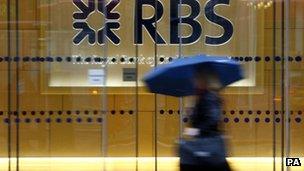Treasury's dilemma over RBS break-up
- Published
- comments

RBS chief executive Stephen Hester said the collapse was "disappointing"
In a way the mystery is why it has taken so long for RBS's sale of 316 branches to Santander to collapse.
It has been clear almost from the start in 2009, when the European Commission obliged RBS to dispose of these branches as a way of injecting greater competition into the small-business banking market, that it would be a nightmarishly difficult deal to execute.
The banking industry was in crisis and most banks were trying to retrench rather than expand, so there were never going to be many buyers.
In the end, there was only one, Santander.
But that was only the start of the challenge for RBS.
Persuading more than two million customers to move to a new bank was always going to be hard.
And seamlessly transferring the computerised accounts from RBS's patched-up old systems to Santander's was a mammoth and complex task.
Inevitably the process has been hit by repeated delays.
A deal that originally supposed to have been completed at the end of 2011 was - according to my sources at Santander - looking as though it would not finally happen until 2015.
So late on Thursday RBS was told by Santander that all bets were off.
Who is to blame for the debacle?
Well the official approach being taken by both sides is that the termination is just one of those things. The two banks' press releases are studies in polite obfuscation about what went wrong.
Privately they are not quite so politically correct.
'Tired of waiting'
Broadly, Santander says it was tired of waiting for the new customers to arrive - and says RBS's inefficiency and complex computer systems was the cause of the seemingly interminable delays.
As for RBS, it says that Santander's own IT team was intimately involved in the process of hiving off the business, and had been dragging its feet for months.
Is anyone bitter? You bet.
What of course everyone is at pains to say is that no one should read into this that Santander got cold feet because in any way its UK business has been damaged and weakened by the financial and economic mess in its home Spanish market.
As I have mentioned many times, Santander in the UK is a ring-fenced subsidiary, with its own discrete capital resources. It is in robust financial health (or as robust as is possible for any British bank at a time of economic stagnation).
But it is quite consistent with Santander in Britain being in rude health for it also to be little short of barking mad for Santander as group to be acquiring yet more assets and liabilities anywhere - including the UK - at a moment when Spain as an economy is an evolving and dangerous crisis.
So RBS's view, for what it is worth, is that Santander has for some considerable time been looking for a reason to escape from this big commitment to expand.
Of course Santander denies this.
What now?
Where does it leave the banks?
Well Santander is the same as it ever was: an effective challenger in the retail market, but with too few small-business customers to count as much of a player in that economically important end of the market.
As for RBS, it never wanted to sell the branches. Being mandated to do so by the European Commission significantly depleted its ability to create incremental income for its shareholders. And the costs of carving out the branches for sale has so far cost it many hundreds of million pounds.
Will RBS be fined by the Commission for failing to sell the branches by the target date - which now looks inevitable, given that there is no obvious buyer to replace Santander and what's on offer may be too small to be floated off as a viable independent standalone bank?
RBS and the Treasury - which will negotiate with Commission on RBS's behalf - both think that punishing RBS would be unfair and unlikely.
They make three points:
That RBS's execution of the sale has been monitored to demonstrate that it was worked assiduously (if unsuccessfully) to complete the deal.
That RBS has sold or almost sold a whole bunch of other very valuable assets that the Commission ordered to be hived off (including the insurer Direct Line, a global payments business and a big commodities trader).
That all eurozone banks are now in receipt of enormous subsidies in the form of huge cheap three-year loans from the European Central Bank, so it no longer looks quite so fair to muller RBS for being bailed out by British taxpayers in 2009.
The collapse of the disposal does however put the government in a difficult position.
On the one hand, as the biggest shareholder in RBS by far, with more than 80% of the shares, HM Treasury would reap a financial reward if the Commission agreed to cancel a forced sale which is highly damaging to the wealth of RBS's owners.
Against that, it is important government policy to increase competition in a banking industry widely perceived to be lacking in sufficient competitive tension. The transfer to Santander of all those branches and customers was intended to give the big banks a serious run for their money in the provision of credit to smaller companies - a service perceived to be vital to rehabilitating the British economy.
So what is the chancellor's priority - structural reform of the banking industry to increase choice or minimising the risk that taxpayers will incur huge losses on the 2008 rescue of RBS?
UPDATE 14:53
Two other fairly important things to mention:
First, we will know in the coming week whether RBS will be allowed by the Financial Services Authority and the Treasury to withdraw from the Asset Protection Scheme.
This is the insurance policy against losses on a few hundred billion pounds of dodgy loans and assets provided to RBS by the government in 2009.
At the time, it was seen as a useful alternative to RBS raising even more expensive capital from taxpayers.
Today, from RBS's point of view, the APS has become a very expensive insurance policy: RBS no longer owns most of the insured assets, so is paying £500m a year to taxpayers for a service it no longer needs.
RBS would love to have that £500m of income back.
Second, RBS seems to be surprisingly happy that the sale of the branches to Santander has collapsed.
Apparently, these branches and associated assets generate £300m a year - net income RBS is delighted to retain for as long as possible.
That said, getting rid of them may be easier than I thought.
RBS has already received approaches from two institutions interested in picking up where Santander left off.
And if those potential bidders evaporate, RBS thinks it may be able to rebrand the branches as Williams & Glyn's (a bank it once owned) with a view to floating them on the stock market.
- Published12 October 2012
